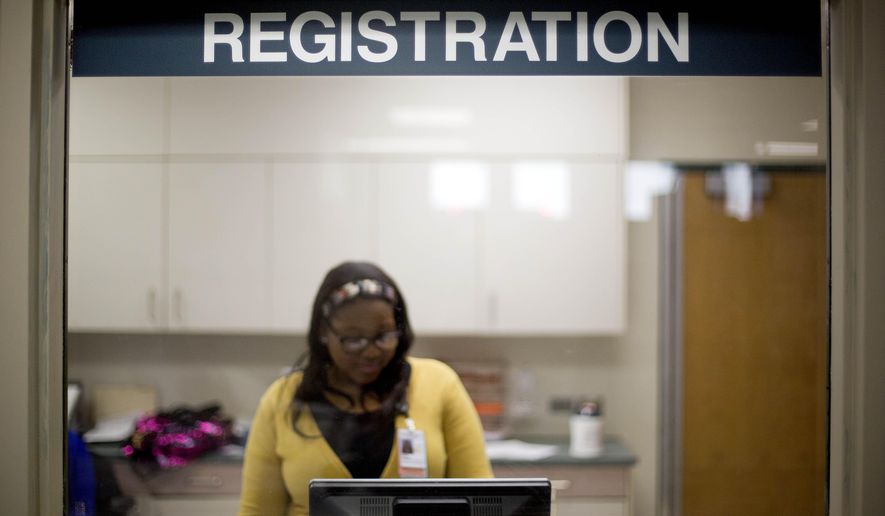Doctors say emergency room visits have increased since the advent of Obamacare, undercutting one of the key selling points of President Obama’s health care law, which was supposed to ensure a healthier population by pushing consumers to rely on their primary physicians rather than emergency trips to the hospital.
Three out of four ER doctors said they have seen a rise in the number of patients since January 2014, when Obamacare fully kicked in, according to a survey conducted by the American College of Emergency Physicians. More than a quarter of the doctors said they have seen a major surge, and 47 percent said the rise has been slight.
The doctors said they fear a spike in visits could overwhelm their resources: Seven out of 10 said their departments aren’t prepared for a significant increase in patient volume.
The biggest cause is a lack of primary care doctors to treat the increased number of patients with health care coverage, so the patients are turning to the emergency room instead — exactly what wasn’t supposed to happen.
“Just because people have health insurance does not mean they have access to timely medical care,” said Michael Gerardi, president of the American College of Emergency Physicians.
Some patients also may be in the habit of turning to emergency rooms or have a hard time getting away from work for daytime checkups.
“There’s such a hassle factor in making an appointment,” said Avik Roy, a senior fellow at the conservative Manhattan Institute. “It’s just a lot easier to show up at the emergency room.”
Mr. Obama vowed that his health care plan would make a dent in the high rate of emergency room visits, particularly for the uninsured. Siphoning these patients to primary care doctors was expected to cut overall costs by catching health problems earlier and by diverting patients away from more expensive emergency room care.
The Health and Human Services Department, which is overseeing implementation of the Affordable Care Act, said it’s trying to get patients to change their habits while broadening primary care options.
“For people who have utilized emergency rooms for non-emergency care in the past, we are continuing to work to reach out and provide information on how to best use their new coverage,” said Aaron Albright, a spokesman for the Centers for Medicare and Medicaid Services. “The Affordable Care Act is also making critical investments to train more doctors and nurses, especially in communities that have lacked access to quality, affordable care in the past.”
The poll, conducted in March, had 2,099 respondents and a margin of error of 2.1 percentage points. Doctors from three large states — California, Texas and New York — accounted for a quarter of the responses.
A majority of the doctors said they are seeing more Medicaid patients in the ER.
Millions of people have been added to the rolls of Medicaid, which is the federal-state health care program for the poor, but beneficiaries are struggling to find doctors willing to accept the relatively low reimbursements the program offers.
Because Obamacare covers emergency room visits, showing up at a hospital is a viable option for more people.
Obamacare critics said the poll results were not surprising.
A study published right as Obamacare’s individual mandate took effect in 2014 found Oregonians who obtained Medicaid benefits in a 2008 lottery used emergency rooms at a 40 percent higher rate than did people who remained uninsured.
According to its authors, “basic economic theory suggests that by reducing the out-of-pocket cost of a visit that an uninsured person would face, Medicaid coverage should increase use of the emergency department.”
Another study, however, found a modest decrease in ER visits in 2011 among young adults who were able to stay on their parents’ plans until age 26 because of Obamacare.
Still to be seen is whether the results are just a blip. Caroline Pearson, a vice president at the Avalere Health consultancy, said she expects insurers to do “a fair amount of outreach and care management” to get their Obamacare customers to change their ER habits.
In a speech Monday, HHS Secretary Sylvia Mathews Burwell credited Obamacare for a $7.4 billion decrease in 2014 in what is known as uncompensated care — the unreimbursed cost of care provided by hospitals to people who are uninsured or underinsured.
However, she said, there is “still more work to do to make sure consumers know how to use their insurance, to connect their coverage with their care.”
Analysts said Ms. Burwell’s comments don’t contradict the poll’s findings, which focused on patient volume during Obamacare’s short run and did not dive into their insurance status.
Although uncompensated costs may be declining, Mr. Roy said, it is important to note how much money the government spent to achieve that result.
Obamacare’s framers he said, replaced “one free-rider program” with another through a massive increase in federal spending on government-subsidized insurance.
A chunk of that spending is the subject of a Supreme Court ruling due by June.
The justices will decide whether the IRS has been unlawfully paying the subsidies to customers in at least 34 states that decided not to set up their own Obamacare exchanges. In those cases, the federal government has stepped in to set up the insurance marketplaces — but the way the Affordable Care Act is written, it’s not clear whether customers in those states are eligible for the subsidies.
If the subsidies are struck down, coverage could become unaffordable for millions of people.
In that scenario, 42 percent of physicians said they would expect ER visits to increase, 31 percent said the number would stay the same and 10 percent said ER visits would decrease, according to Monday’s poll.
About two-thirds said their reimbursements for providing emergency care would decrease if the federal subsidies are taken away from their states.
• Tom Howell Jr. can be reached at thowell@washingtontimes.com.




Please read our comment policy before commenting.